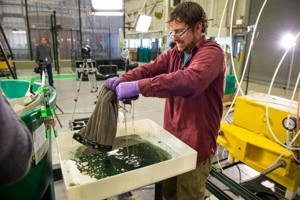A reusable sponge could ‘revolutionize’ oil spill, diesel cleanup
CHICAGO -- Scientists at the US Department of Energy's Argonne National Laboratory have invented a new foam, called Oleo Sponge, that can be used to clean up oil and diesel spills in water. The material not only quickly adsorbs oil from water, but also is reusable and can pull dispersed oil from the entire water column—not just the surface.
"The Oleo Sponge offers a set of possibilities that, as far as we know, are unprecedented," said co-inventor Seth Darling, a scientist with Argonne's Center for Nanoscale Materials and a fellow of the University of Chicago's Institute for Molecular Engineering.
The scientists began with common polyurethane foam, used in furniture cushions to home insulation. This foam has lots of nooks and crannies, which could provide surface area to grab oil. They used a nanotechnology technique previously developed at Argonne to infuse a hard layer of "primer" into the foam. This gave the foam a new surface chemistry, so they could firmly attach a second layer of molecules that grab oil.
At tests at a giant seawater tank in New Jersey called Ohmsett, the National Oil Spill Response Research & Renewable Energy Test Facility, the Oleo Sponge successfully collected diesel and crude oil from both below and on the water surface.
"The material is extremely sturdy. We've run dozens to hundreds of tests, wringing it out each time, and we have yet to see it break down at all," Darling said.
Oleo Sponge could potentially also be used routinely to clean harbors and ports, where diesel and oil tend to accumulate from ship traffic.
The team is actively looking to commercialize the material.
The research was funded by the US Coast Guard and the Bureau of Safety and Environmental Enforcement. The team used resources of the Center for Nanoscale Materials, a US Department of Energy Office of Science User Facility, in the development of the material.







Comments